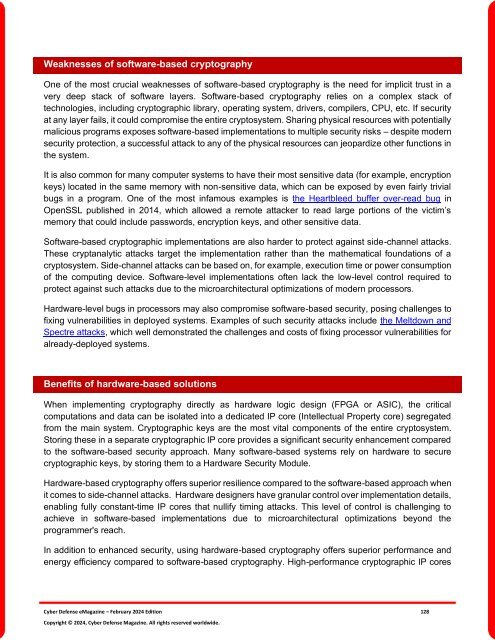The Cyber Defense eMagazine February Edition for 2024
Cyber Defense eMagazine February Edition for 2024 #CDM #CYBERDEFENSEMAG @CyberDefenseMag by @Miliefsky a world-renowned cyber security expert and the Publisher of Cyber Defense Magazine as part of the Cyber Defense Media Group as well as Yan Ross, Editor-in-Chief and many more writers, partners and supporters who make this an awesome publication! 155 page February Edition fully packed with some of our best content. Thank you all and to our readers! OSINT ROCKS! #CDM #CDMG #OSINT #CYBERSECURITY #INFOSEC #BEST #PRACTICES #TIPS #TECHNIQUES
Cyber Defense eMagazine February Edition for 2024 #CDM #CYBERDEFENSEMAG @CyberDefenseMag by @Miliefsky a world-renowned cyber security expert and the Publisher of Cyber Defense Magazine as part of the Cyber Defense Media Group as well as Yan Ross, Editor-in-Chief and many more writers, partners and supporters who make this an awesome publication! 155 page February Edition fully packed with some of our best content. Thank you all and to our readers! OSINT ROCKS! #CDM #CDMG #OSINT #CYBERSECURITY #INFOSEC #BEST #PRACTICES #TIPS #TECHNIQUES
You also want an ePaper? Increase the reach of your titles
YUMPU automatically turns print PDFs into web optimized ePapers that Google loves.
Weaknesses of software-based cryptography<br />
One of the most crucial weaknesses of software-based cryptography is the need <strong>for</strong> implicit trust in a<br />
very deep stack of software layers. Software-based cryptography relies on a complex stack of<br />
technologies, including cryptographic library, operating system, drivers, compilers, CPU, etc. If security<br />
at any layer fails, it could compromise the entire cryptosystem. Sharing physical resources with potentially<br />
malicious programs exposes software-based implementations to multiple security risks – despite modern<br />
security protection, a successful attack to any of the physical resources can jeopardize other functions in<br />
the system.<br />
It is also common <strong>for</strong> many computer systems to have their most sensitive data (<strong>for</strong> example, encryption<br />
keys) located in the same memory with non-sensitive data, which can be exposed by even fairly trivial<br />
bugs in a program. One of the most infamous examples is the Heartbleed buffer over-read bug in<br />
OpenSSL published in 2014, which allowed a remote attacker to read large portions of the victim’s<br />
memory that could include passwords, encryption keys, and other sensitive data.<br />
Software-based cryptographic implementations are also harder to protect against side-channel attacks.<br />
<strong>The</strong>se cryptanalytic attacks target the implementation rather than the mathematical foundations of a<br />
cryptosystem. Side-channel attacks can be based on, <strong>for</strong> example, execution time or power consumption<br />
of the computing device. Software-level implementations often lack the low-level control required to<br />
protect against such attacks due to the microarchitectural optimizations of modern processors.<br />
Hardware-level bugs in processors may also compromise software-based security, posing challenges to<br />
fixing vulnerabilities in deployed systems. Examples of such security attacks include the Meltdown and<br />
Spectre attacks, which well demonstrated the challenges and costs of fixing processor vulnerabilities <strong>for</strong><br />
already-deployed systems.<br />
Benefits of hardware-based solutions<br />
When implementing cryptography directly as hardware logic design (FPGA or ASIC), the critical<br />
computations and data can be isolated into a dedicated IP core (Intellectual Property core) segregated<br />
from the main system. Cryptographic keys are the most vital components of the entire cryptosystem.<br />
Storing these in a separate cryptographic IP core provides a significant security enhancement compared<br />
to the software-based security approach. Many software-based systems rely on hardware to secure<br />
cryptographic keys, by storing them to a Hardware Security Module.<br />
Hardware-based cryptography offers superior resilience compared to the software-based approach when<br />
it comes to side-channel attacks. Hardware designers have granular control over implementation details,<br />
enabling fully constant-time IP cores that nullify timing attacks. This level of control is challenging to<br />
achieve in software-based implementations due to microarchitectural optimizations beyond the<br />
programmer's reach.<br />
In addition to enhanced security, using hardware-based cryptography offers superior per<strong>for</strong>mance and<br />
energy efficiency compared to software-based cryptography. High-per<strong>for</strong>mance cryptographic IP cores<br />
<strong>Cyber</strong> <strong>Defense</strong> <strong>eMagazine</strong> – <strong>February</strong> <strong>2024</strong> <strong>Edition</strong> 128<br />
Copyright © <strong>2024</strong>, <strong>Cyber</strong> <strong>Defense</strong> Magazine. All rights reserved worldwide.

















